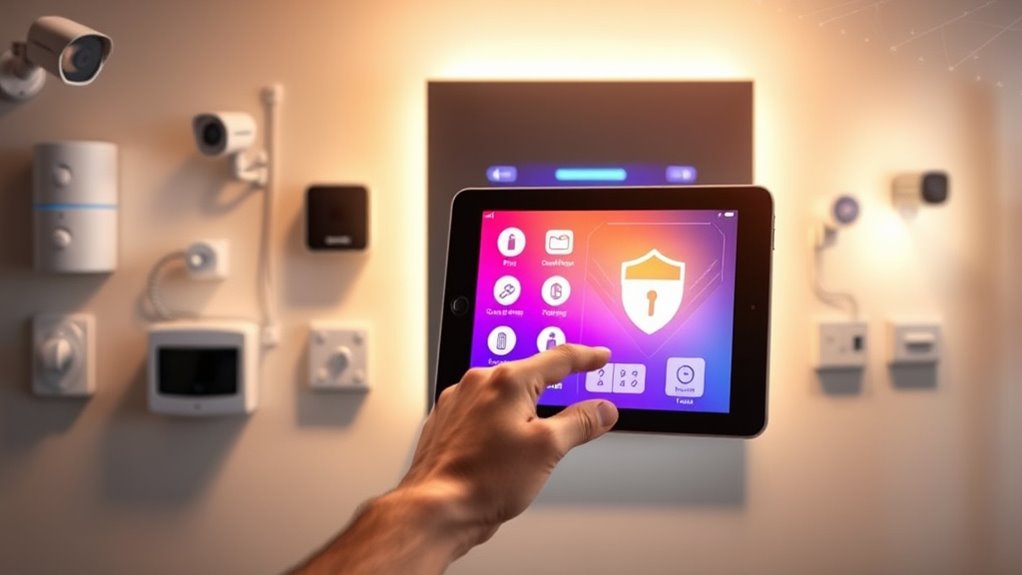To prevent pass-the-token exploits in smart-home apps, you should issue unique, high-entropy tokens for each session, and guarantee they expire quickly to limit reuse. Always encrypt data in transit with protocols like TLS and store tokens securely on devices. Using multi-factor authentication adds extra protection. Regularly update software and monitor network activity for suspicious behavior. Staying vigilant and adopting these best practices helps safeguard your connected environment—keep exploring for more security measures.
Key Takeaways
- Issue unique, high-entropy tokens for each session and invalidate them after use or expiration.
- Encrypt all data transmission between devices and servers with TLS to prevent token interception.
- Implement multi-factor authentication to add extra security layers beyond token validation.
- Regularly update apps and device firmware to patch known vulnerabilities and reduce attack surfaces.
- Monitor network activity for unusual sessions or device access, and restrict device access to trusted sources.

As smart-home apps become more popular, so do the risks of pass-the-token exploits that can give hackers unauthorized access to your devices. These exploits often hinge on vulnerabilities like token reuse and session hijacking, which can turn a simple breach into a full control of your connected environment. When a token is reused across multiple sessions, it creates an open door for attackers to exploit if they manage to intercept or steal it. Once they have that token, they can impersonate you and take over your devices without your knowledge. Similarly, session hijacking occurs when an attacker intercepts a valid session token, effectively hijacking your session and gaining access as if they were you. This can happen if your app or network isn’t properly secured, making it essential to understand and address these risks.
Smart-home apps face risks from token reuse and session hijacking that can grant hackers full control of your devices.
To prevent token reuse, you need to guarantee that your smart-home app issues unique tokens for each session and invalidates them once they’re used or expired. This prevents hackers from reusing stolen tokens and minimizes the window of opportunity for exploitation. Implementing short-lived tokens can also help, as they automatically expire after a set period, reducing the chances of token reuse over time. Additionally, employing secure storage for tokens on your device ensures they aren’t easily accessible to malicious actors. Never store tokens in plain text or insecure locations, and always encrypt them in transit and at rest. Utilizing high-entropy tokens can further strengthen security by making token guessing exceedingly difficult.
Session hijacking can be thwarted by encrypting all communications between your device and the app’s servers using protocols like TLS. This encryption prevents attackers from intercepting tokens during transmission, reducing the risk of session hijacking. Multi-factor authentication (MFA) adds an extra layer of security, making it harder for hackers to use stolen tokens even if they manage to intercept them. Regularly updating your app and device firmware is essential, as developers continuously patch vulnerabilities that could otherwise be exploited for session hijacking.
You should also monitor your network for unusual activity. If you notice unfamiliar sessions or devices accessing your smart home, it could indicate an ongoing attack. Changing your passwords regularly and restricting access to trusted devices further minimizes the attack surface. Educating yourself about potential vulnerabilities and staying vigilant helps you stay one step ahead of hackers. By adopting these practices, you considerably reduce the risk of pass-the-token exploits and keep your smart home safe from unauthorized access.
Frequently Asked Questions
How Can Users Identify if Their Smart-Home App Is Vulnerable?
You can identify if your smart-home app is vulnerable by checking your device firmware and user permissions. If your firmware is outdated or hasn’t received recent updates, vulnerabilities may exist. Also, review user permissions to guarantee only trusted users have access; excessive permissions can expose your system to pass-the-token exploits. Regularly update your device firmware and limit permissions to reduce the risk of exploitation.
What Are the Common Signs of a Pass-The-Token Attack?
You’ll notice network anomalies like unusual traffic or slow responses, which can hint at a pass-the-token attack. Unauthorized access to your smart-home devices might also occur, such as unfamiliar login attempts or unexpected device controls. Stay alert for these signs, and if you see them, review your app’s security, change passwords, and monitor your network closely to prevent further exploits.
Are There Legal Consequences for Exploiting Smart-Home App Vulnerabilities?
Yes, exploiting smart-home app vulnerabilities can lead to serious legal repercussions. You might face criminal charges or civil lawsuits, depending on the severity and intent of your actions. Ethical considerations also play a vital role, as unauthorized access compromises privacy and safety. It is imperative to understand that hacking into smart-home systems isn’t just risky legally but also morally wrong, emphasizing the importance of responsible behavior and respecting user privacy.
How Often Should Developers Update Security Protocols for Smart-Home Apps?
Think of your smart-home app as a fortress needing constant reinforcement. You should update security protocols regularly, ideally every few months, to stay ahead of threats. Conduct frequent security audits and firmware updates to patch vulnerabilities and strengthen defenses. This proactive approach guarantees your system remains resilient, preventing exploits like pass-the-token attacks. Staying vigilant with timely updates keeps your smart home secure and your users’ trust intact.
Can Third-Party Integrations Increase the Risk of Token Exploits?
Yes, third-party integrations can increase the risk of token exploits. Third-party risks and integration vulnerabilities often introduce security gaps, making it easier for attackers to exploit tokens. You should carefully vet and monitor third-party services, make certain they follow strict security standards, and regularly update your app’s security protocols. By doing so, you reduce the chances of token theft and protect your smart-home ecosystem from potential exploits.
Conclusion
So, next time you think your smart home is invincible, remember how easy it is for a simple pass-the-token exploit to turn your sanctuary into a hacker’s playground. You might trust those sleek apps, but don’t forget—they’re just waiting for a tiny slip to *unseal* chaos. Ironically, your greatest security might be in the very apps you rely on daily, reminding you that even the smartest homes can be the easiest targets. Stay vigilant.








